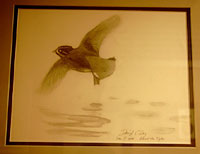

 | |||||||||||||
|
|
Journals 2008/2009Karen Rudio
September 15, 2008 Yesterday evening I watched the multi-net being launched. It was not an easy task. It has to be hooked up correctly to the winch and put over the side right-side up. Two students from the University of Alaska Fairbanks, Allison Payne and Jeannette Cochran, are on the night shift and work with Ken Coyle. This morning I asked Ken how it went and he said he got some good data. They did stations GAK6-10. I slept soundly last night and didn't wake up until about 8:30 am. Most people were up already. Imme, Russ's graduate student from Germany, was in the galley preparing one of the replacement flow meters for the plankton net, while I ate my breakfast. The flow meter measures how much water goes through the net when samples are taken. I learned that it costs about $150 to send a flow meter back to the factory for repairs. A new flow meter costs about $400.
This morning I helped Katherine collect more water samples. We did stations GAK7i through GAK11. That's seven stations total since from GAK10; are no more intermediate stations. Later on I joined Brad in the bird look-out station. The overall number of birds has increased and we saw a few new species such as a Laysan's Albatross, a South Polar Skua, a Mottled Petrel, a Fork-tailed Storm Petrel and a Leach's Storm Petrel. Brad says they follow ships hoping for a hand-out. They are successful at getting scraps from fishing boats.
Brad also told me to check out the drawing of a Whiskered Auklet just outside the entrance to the galley. It was drawn by the famous bird expert, David Sibley. He had joined a Tiglax cruise to the Aleutians specifically to see that small sea bird as it was the only North American species he hadn't seen yet.
At lunch today, Imme took out some ice cream for dessert. The name of the flavor was Udderly Chocolate. She asked me what "udderly" meant. I explained that an udder is the part of the cow that you milk. Perhaps something was lost in translation because Imme was so bothered by the explanation that she put that flavor back into the freezer and pulled out cookies and cream instead. She said, "cookies I know and like." After lunch I had another informative talk with Russ. This expedition is being funded by the North Pacific Research Board. There are five main scientists involved in this project. Katherine's supervisor, Terry Whiteledge is looking at water chemistry and measuring the chlorophyll and nutrients such as nitrogen and iron in the water. Andy's supervisor, Jeremy Mathis is also a chemist, but he is studying the carbon cycle. Tom Weingartner is a physical oceanographer. He will be studying the data collected by ship's research engineer David Leech on temperature, salinity and water flow. Ken Coyle is good at identifying which zooplankton are present and measuring the amount of variation from year to year. Plus, he has excellent computer skills. Russ Hopcroft also studies zooplankton, but is focused on different rates such as growth rates and production rates. He also coordinates things and organizes the data. I stayed up late enough to watch them cast off the multi-net again. They did GAK 11-GAK13 last night. Unfortunately the rough seas caused one of the nets to rip off of the canvas. Volcanology graduate student, Allison Payne was able to do some sewing repairs and attach a spare net using dental floss. |
||||||||||||


